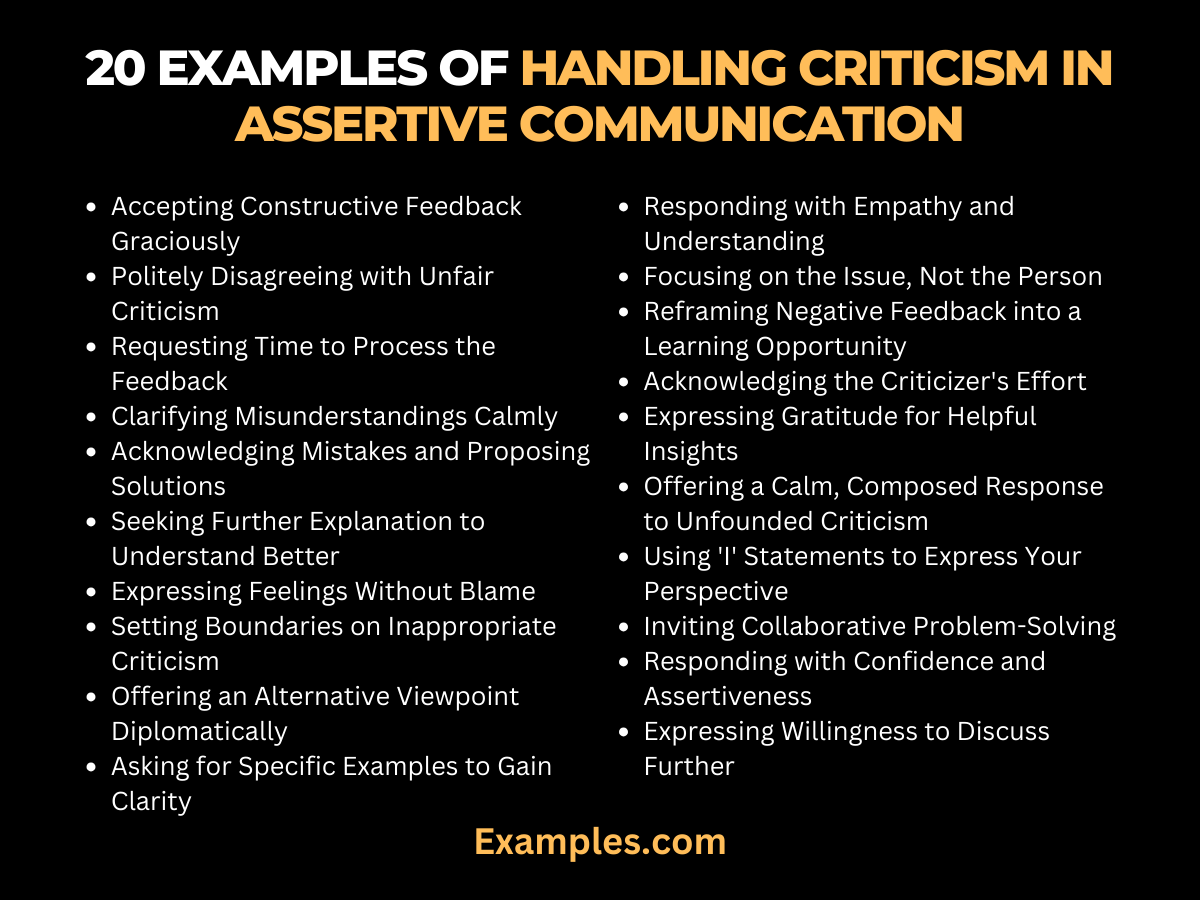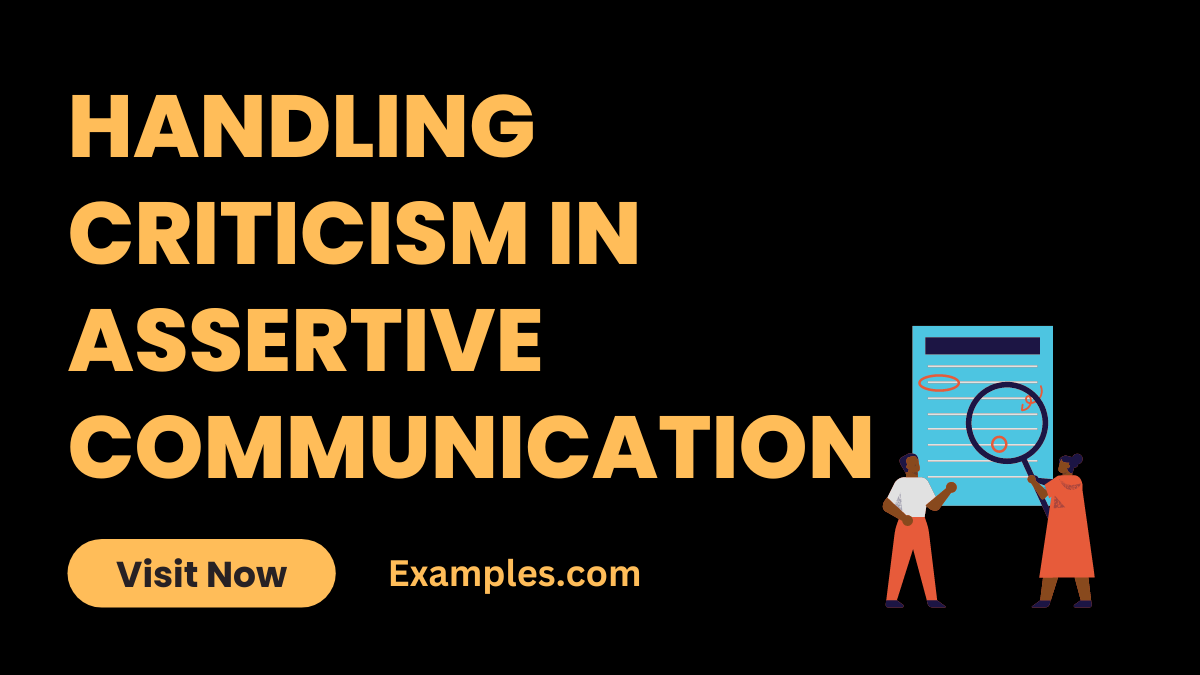19+ Handling Criticism in Assertive Communication Examples
In the dynamic world of professional and personal interactions, mastering the art of Handling Criticism in Assertive Communication is crucial. This comprehensive guide delves into effective strategies, enriched with practical oral communication examples, to help you navigate through feedback and criticism assertively. By integrating key principles of assertive communication, you’ll learn how to respond constructively, maintain confidence, and foster positive outcomes in various scenarios. Embrace this journey to enhance your communication skills and transform challenges into opportunities for growth.
20 Examples of Handling Criticism in Assertive Communication
Navigating the waters of criticism can be challenging, but with the right approach, it becomes an opportunity for personal and professional growth. Our guide on “20 Examples of Handling Criticism in Assertive Communication” provides actionable strategies to effectively manage feedback. Each example, complete with a two-line explanation, demonstrates how to communicate assertively, ensuring your responses are respectful, confident, and constructive. This resource is tailored to help you transform criticism into a stepping stone for improvement, fostering a positive atmosphere in any interaction.

- Accepting Constructive Feedback Graciously: “I appreciate your feedback. Can you provide more specific examples to help me understand better?” This approach shows openness to improvement and a desire for clarity.
- Politely Disagreeing with Unfair Criticism: “I understand your point, but here’s my perspective…” Expressing your view respectfully maintains assertiveness without escalating the situation.
- Requesting Time to Process the Feedback: “Thank you for your input. I’d like some time to think about this before responding.” It shows you value the feedback but need time to assess it properly.
- Clarifying Misunderstandings Calmly: “I believe there’s been a misunderstanding. Here’s what I meant…” Clearing up misconceptions shows your willingness to communicate effectively.
- Acknowledging Mistakes and Proposing Solutions: “I realize I made a mistake there. Here’s what I plan to do to fix it.” Owning up to errors and suggesting remedies displays responsibility and initiative.
- Seeking Further Explanation to Understand Better: “Could you elaborate on that point? I want to understand your perspective fully.” This shows your commitment to fully grasping the feedback.
- Expressing Feelings Without Blame: “When that happened, I felt… because…” Communicating your feelings without assigning blame fosters a constructive conversation.
- Setting Boundaries on Inappropriate Criticism: “I am open to constructive feedback, but personal comments are not acceptable.” This ensures a professional tone is maintained.
- Offering an Alternative Viewpoint Diplomatically: “That’s an interesting point. Have you considered…?” Presenting your perspective in a non-confrontational manner promotes healthy dialogue.
- Asking for Specific Examples to Gain Clarity: “Can you give me an example of that so I can understand better?” This seeks clarity and shows a willingness to engage with the feedback.
- Responding with Empathy and Understanding: “I see why you feel that way. Let’s find a solution together.” This approach builds rapport and shows you value their feelings.
- Focusing on the Issue, Not the Person: “Let’s focus on solving the problem at hand rather than assigning blame.” This keeps the conversation objective and solution-focused.
- Reframing Negative Feedback into a Learning Opportunity: “This gives me a chance to improve. I’m grateful for your honesty.” Viewing criticism as a learning opportunity displays a positive attitude.
- Acknowledging the Criticizer’s Effort: “Thank you for taking the time to share your thoughts with me.” This shows appreciation for their effort, fostering mutual respect.
- Expressing Gratitude for Helpful Insights: “Your feedback is valuable to me. Thank you for helping me grow.” Gratitude can turn a potentially negative interaction into a positive one.
- Offering a Calm, Composed Response to Unfounded Criticism: “I understand your concerns, but here are the facts…” A calm response to unfounded criticism keeps the conversation rational.
- Using ‘I’ Statements to Express Your Perspective: “I feel that my approach was effective because…” Using ‘I’ statements helps in expressing your viewpoint without sounding confrontational.
- Inviting Collaborative Problem-Solving: “How can we work together to resolve this?” This encourages teamwork and shows a willingness to find a mutual solution.
- Responding with Confidence and Assertiveness: “I stand by my decision, and here’s why…” Confidently defending your decisions while being open to discussion shows assertiveness.
- Expressing Willingness to Discuss Further: “I’m open to discussing this more if you have additional thoughts.” This shows you’re approachable and committed to understanding their point of view.
Assertive Communication Handling Criticism in Workplace
In today’s collaborative work environments, mastering Assertive Communication Handling Criticism in the Workplace is essential. This guide offers ten unique examples, each accompanied by a succinct explanation, demonstrating how to apply assertive communication techniques in professional settings. These examples will equip you with the skills to handle workplace criticism constructively, ensuring you maintain composure, respect, and effectiveness in your responses. Enhance your workplace interactions and foster a more positive, productive work culture with these practical strategies.

- Responding to Performance Feedback Positively: “I appreciate your feedback on my performance. How can I integrate these insights to improve?” This shows a proactive attitude towards personal development.
- Addressing Criticism from a Superior Diplomatically: “I understand your concerns. Could we discuss how I might approach this differently?” Engaging in dialogue shows respect and willingness to adapt.
- Handling Peer Review with Openness: “Thank you for your perspective. Let’s explore how we can work together more effectively.” This fosters collaboration and mutual respect among colleagues.
- Dealing with Unjust Criticism Assertively: “I hear your point, but I believe there are other factors to consider.” Assertively addressing unfair criticism while remaining open to discussion.
- Managing Feedback in Team Meetings with Grace: “Thanks for the input. Can we delve deeper into this after the meeting?” Shows you value team input while maintaining meeting focus.
- Navigating Criticism During Performance Appraisals: “Your feedback is valuable. Can we set some goals based on these insights?” Turning appraisal feedback into actionable goals demonstrates a growth mindset.
- Constructive Response to Constructive Criticism: “I understand your point and here’s how I plan to address it.” Acknowledging valid criticism and outlining a plan shows responsibility and initiative.
- Balancing Emotional Responses in Tough Conversations: “I appreciate your honesty. I need a moment to process this feedback.” Taking time to process emotions ensures a measured, thoughtful response.
- Engaging in Solution-Focused Dialogue with Superiors: “I see your point. What solutions would you suggest for improvement?” Inviting superiors’ input for solutions shows respect and eagerness to improve.
- Building Rapport While Addressing Criticism: “This feedback is helpful. Let’s use it as a stepping stone for our project’s success.” Using criticism as a collaborative tool to enhance team projects.
Strategies for Handling Criticism in Assertive Communication
Developing Strategies for Handling Criticism in Assertive Communication is vital for maintaining healthy, productive relationships. This segment presents ten unique examples, each with a brief explanation, illustrating effective strategies to manage criticism through assertive communication. These examples will help you transform criticism into constructive dialogue, enhancing both personal and professional relationships. Embrace these strategies to communicate assertively, respond to criticism constructively, and foster an environment of mutual respect and understanding.

- Expressing Understanding Before Responding: “I see where you’re coming from. Here’s my perspective.” Demonstrating understanding first establishes a foundation for constructive dialogue.
- Maintaining Professionalism in Heated Discussions: “Let’s try to keep this conversation focused and respectful.” Ensuring discussions stay professional, even under stress.
- Using Specific Examples in Responses: “When you mentioned X, I thought of Y as a possible solution.” Responding with specific examples shows engagement and thoughtfulness.
- Inviting Feedback for Personal Growth: “I value your opinion. How can I do better next time?” Actively seeking feedback demonstrates a commitment to continuous improvement.
- Acknowledging Areas of Improvement Openly: “I agree that I need to work on X. Here’s my plan.” Openly accepting areas for improvement shows maturity and self-awareness.
- Responding to Group Criticism Constructively: “Thank you for the group’s feedback. Let’s discuss how we can address these concerns together.” This promotes a team-oriented approach to problem-solving.
- Utilizing a Calm Tone in Challenging Conversations: “I’d like to discuss this calmly to understand your perspective better.” A calm tone helps in maintaining a constructive atmosphere.
- Reflecting on Feedback Before Reacting: “I need some time to think about your points before I respond.” Reflecting before reacting ensures a more considered and effective response.
- Offering Alternatives When Disagreeing: “I see it differently. What if we tried this approach instead?” Proposing alternatives when disagreeing shows flexibility and creativity.
- Reinforcing Mutual Goals in Response: “Our goal is the same. How can we achieve it together despite these challenges?” Focusing on mutual goals can bridge differences and foster cooperation.
How Do You Handle Criticism in Assertive Communication?
Handling criticism in Assertive Communication involves a balanced blend of respect, clarity, and confidence. It’s about responding to feedback, whether positive or negative, in a way that maintains your dignity and the respect of others. The key is to listen actively, process the information, and respond thoughtfully. Here’s how to do it:
- Active Listening: Begin by listening without interrupting. Understand the criticism fully before formulating your response. This demonstrates respect and willingness to consider others’ viewpoints.
- Stay Calm and Composed: Maintain emotional control. Responding in anger or defensiveness can escalate the situation and impede effective communication.
- Clarify if Needed: If the criticism is unclear, ask for specific examples or further explanation. This ensures you’re responding to the actual issue at hand.
- Use ‘I’ Statements: Express your feelings and thoughts using ‘I’ statements. This minimizes defensiveness and focuses on your perspective.
- Acknowledge Valid Points: If the criticism has merit, acknowledge it. This shows you’re open to growth and self-improvement.
- Provide Your Perspective: Share your side of the story in a clear and concise manner. Ensure your response is honest but respectful.
- Seek a Constructive Outcome: Propose solutions or ask for suggestions on how to improve. This transforms criticism into a learning opportunity.
- Follow Up: If necessary, suggest revisiting the conversation once you’ve had time to reflect or after changes have been implemented.
By integrating these steps into your communication style, you can transform criticism from a potentially negative experience into a constructive dialogue that fosters personal and professional growth.
How Can Assertive Communication Techniques be Applied When Receiving Constructive Criticism?
Assertive communication techniques are instrumental when receiving constructive criticism. They enable you to engage in meaningful dialogues where feedback is seen as an opportunity for growth rather than a personal attack. Here’s how to apply these techniques:
- Empathetic Listening: Show empathy by trying to understand the perspective of the person offering criticism. This builds rapport and makes the exchange more constructive.
- Direct and Honest Responses: Respond directly and honestly, but with a respectful tone. This helps in addressing issues head-on while maintaining professionalism.
- Positive Affirmation: Acknowledge the effort of the person providing feedback. A simple ‘thank you’ can demonstrate your appreciation for their input.
- Setting Boundaries: If criticism becomes personal or inappropriate, assertively set boundaries. Politely but firmly state what is acceptable in the feedback process.
- Solution-Oriented Approach: Focus on finding solutions rather than dwelling on the criticism. Suggest or ask for actionable steps to improve.
- Respectful Disagreement: If you disagree, express your viewpoint respectfully. Provide your reasoning in a way that invites dialogue, not conflict.
- Non-Verbal Assertiveness: Use confident body language. Maintain eye contact and a calm demeanor to convey your assertiveness non-verbally.
- Constructive Feedback Loop: Engage in a two-way feedback loop. Offer your constructive feedback on how the process can be more beneficial.



